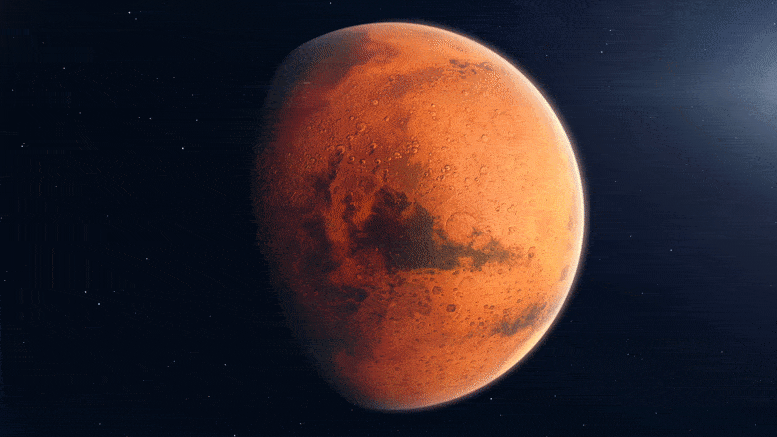
Using NASA’s InSight Mars lander, scientists have precisely measured Mars’ rotation, detecting a subtle acceleration and the planet’s wobble due to its molten core. This study offers unprecedented insights into the Martian core’s size and shape, providing vital information for understanding Mars’ internal structure. Credit: NASA/JPL-Caltech/UArizona.
Data sent by the spacecraft before it retired last December has provided new details about how fast the planet rotates and how much it wobbles.
Scientists have made the most precise measurements ever of Mars’ rotation, for the first time detecting how the planet wobbles due to the “sloshing” of its molten metal core. The findings, detailed in a recent Nature paper, rely on data from NASA’s InSight Mars lander, which operated for four years before running out of power during its extended mission in December 2022.
To track the planet’s spin rate, the study’s authors relied on one of InSight’s instruments: a radio transponder and antennas collectively called the Rotation and Interior Structure Experiment, or RISE. They found the planet’s rotation is accelerating by about 4 milliarcseconds per year² – corresponding to a shortening of the length of the Martian day by a fraction of a millisecond per year.
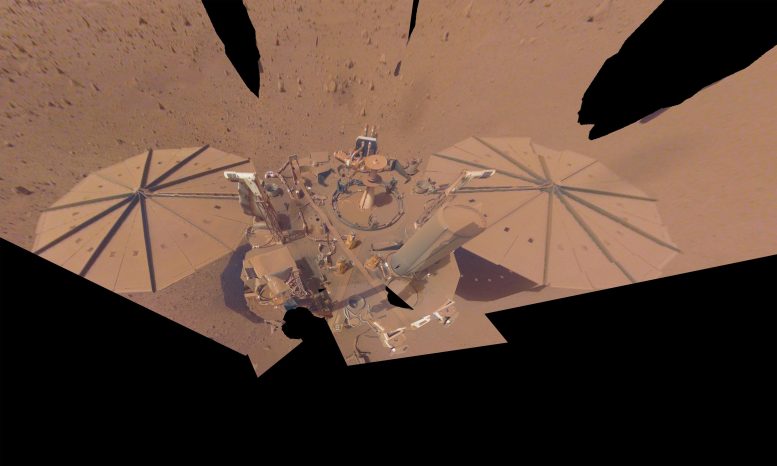
NASA’s InSight lander captured this selfie on April 24, 2022, the 1,211th Martian day, or sol, of the mission. Dust on its solar panels caused the lander to lose power in December of that year, but data recorded by InSight’s instruments is still leading to new science. Credit: NASA/JPL-Caltech. Credit: NASA/JPL-Caltech
Understanding the Acceleration
It’s a subtle acceleration, and scientists aren’t entirely sure of the cause. But they have a few ideas, including ice accumulating on the polar caps or post-glacial rebound, where landmasses rise after being buried by ice. The shift in a planet’s mass can cause it to accelerate a bit like an ice skater spinning with their arms stretched out, then pulling their arms in.
“It’s really cool to be able to get this latest measurement – and so precisely,” said InSight’s principal investigator, Bruce Banerdt of NASA’s Jet Propulsion Laboratory (JPL) in Southern California. “I’ve been involved in efforts to get a geophysical station like InSight onto Mars for a long time, and results like this make all those decades of work worth it.”
This video explains how NASA’s Deep Space Network – made up of multiple giant antenna dishes arrayed at three roughly equidistant ground stations on Earth – helps conduct radio science around planets, moons, and other planetary bodies. Credit: NASA/JPL-Caltech
How RISE Works
RISE is part of a long tradition of Mars landers using radio waves for science, including the twin Viking landers in the 1970s and the Pathfinder lander in the late ’90s. But none of those missions had the advantage of InSight’s advanced radio technology and upgrades to the antennas within NASA’s Deep Space Network on Earth. Together, these enhancements provided data about five times more accurate than what was available for the Viking landers.
In the case of InSight, scientists would beam a radio signal to the lander using the Deep Space Network. RISE would then reflect the signal back. When scientists received the reflected signal, they would look for tiny changes in frequency caused by the Doppler shift (the same effect that causes an ambulance siren to change pitch as it gets closer and farther away). Measuring the shift enabled researchers to determine how fast the planet rotates.
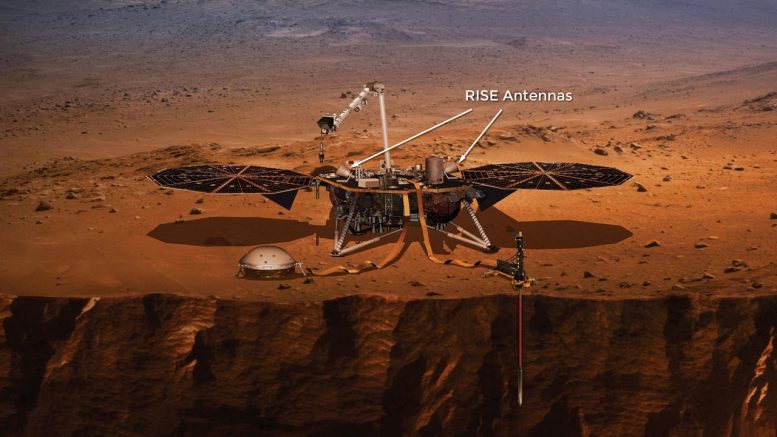
This annotated artist’s concept of NASA’s InSight lander on Mars points out the antennas on the spacecraft’s deck. Along with a radio transponder in the lander, these antennas made up an instrument called the Rotation and Interior Structure Experiment, or RISE. Credit: NASA/JPL-Caltech
Experiment Details
“What we’re looking for are variations that are just a few tens of centimeters over the course of a Martian year,” said the paper’s lead author and RISE’s principal investigator, Sebastien Le Maistre at the Royal Observatory of Belgium. “It takes a very long time and a lot of data to accumulate before we can even see these variations.”
The paper examined data from InSight’s first 900 Martian days – enough time to look for such variations. Scientists had their work cut out for them to eliminate sources of noise: Water slows radio signals, so moisture in the Earth’s atmosphere can distort the signal coming back from Mars. So can the solar wind, the electrons and protons flung into deep space from the Sun.
“It’s a historic experiment,” said Le Maistre. “We have spent a lot of time and energy preparing for the experiment and anticipating these discoveries. But despite this, we were still surprised along the way – and it’s not over, since RISE still has a lot to reveal about Mars.”
Martian Core Measurements
RISE data was also used by the study authors to measure Mars’ wobble – called its nutation – due to sloshing in its liquid core. The measurement allows scientists to determine the size of the core: Based on RISE data, the core has a radius of roughly 1,140 miles (1,835 kilometers).
The authors then compared that figure with two previous measurements of the core derived the from spacecraft’s seismometer. Specifically, they looked at how seismic waves traveled through the planet’s interior – whether they reflected off the core or passed through it unimpeded.
Taking all three measurements into account, they estimate the core’s radius to be between 1,112 and 1,150 miles (1,790 and 1,850 kilometers). Mars as a whole has a radius of 2,106 miles (3,390 kilometers) – about half the size of Earth’s.
Measuring Mars’ wobble also provided details about the shape of the core.
“RISE’s data indicate the core’s shape cannot be explained by its rotation alone,” said the paper’s second author, Attilio Rivoldini of the Royal Observatory of Belgium. “That shape requires regions of slightly higher or lower density buried deep within the mantle.”
While scientists will be mining InSight data for years to come, this study marks the final chapter for Banerdt’s role as the mission’s principal investigator. After 46 years with JPL, he retired on August 1.
Reference: “Spin state and deep interior structure of Mars from InSight radio tracking” by Sébastien Le Maistre, Attilio Rivoldini, Alfonso Caldiero, Marie Yseboodt, Rose-Marie Baland, Mikael Beuthe, Tim Van Hoolst, Véronique Dehant, William M. Folkner, Dustin Buccino, Daniel Kahan, Jean-Charles Marty, Daniele Antonangeli, James Badro, Mélanie Drilleau, Alex Konopliv, Marie-Julie Péters, Ana-Catalina Plesa, Henri Samuel, Nicola Tosi, Mark Wieczorek, Philippe Lognonné, Mark Panning, Suzanne Smrekar and W. Bruce Banerdt, 14 June 2023, Nature.
DOI: 10.1038/s41586-023-06150-0
More About the Mission
JPL managed InSight for NASA’s Science Mission Directorate. InSight was part of the Discovery Program, managed by NASA’s Marshall Space Flight Center in Huntsville, Alabama. Lockheed Martin Space in Denver built the InSight spacecraft, including its cruise stage and lander, and supports spacecraft operations for the mission.
A number of European partners, including France’s Centre National d’Études Spatiales (CNES) and the German Aerospace Center (DLR), supported the InSight mission. CNES provided the Seismic Experiment for Interior Structure (SEIS) instrument to NASA, with the principal investigator at IPGP (Institut de Physique du Globe de Paris). Significant contributions for SEIS came from IPGP; the Max Planck Institute for Solar System Research (MPS) in Germany; the Swiss Federal Institute of Technology (ETH Zurich) in Switzerland; Imperial College London and Oxford University in the United Kingdom; and JPL. DLR provided the Heat Flow and Physical Properties Package (HP3) instrument, with significant contributions from the Space Research Center (CBK) of the Polish Academy of Sciences and Astronika in Poland. Spain’s Centro de Astrobiología (CAB) supplied the temperature and wind sensors.


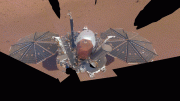
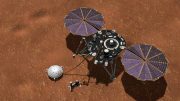

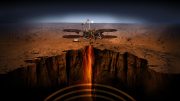
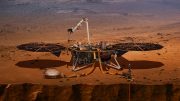
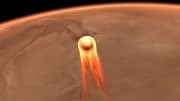
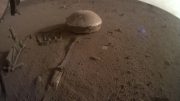
A very excellent work by the scientists involved in this findings. Hope it would be beneficial to space watchers.